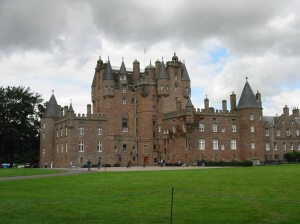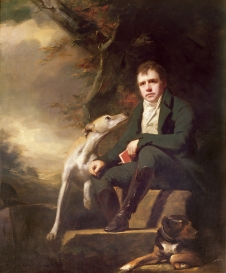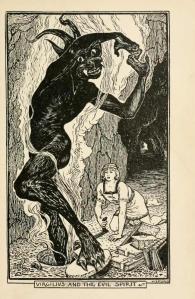Murders, demonic visitations, ghosts (one, a noble woman who was burnt for witchcraft in the 16th century), and monstrous apparitions haunt Glamis Castle, the setting for much of Shakespeare’s bloody play, Macbeth. Glamis Castle– a real place and a popular tourist attraction located in Angus, Scotland– is infamous for its grim mysteries, all of which involve the existence of a secret chamber.
Shakespeare’s Glamis Castle

Glamis castle is the ancestral home of Shakespeare’s tragic character Macbeth and is the setting for the play’s central event: the murder of King Duncan.
Macbeth holds the title “Thane of Glamis,” but finds out from three witches that he is destined to be king. Rather than waiting for his fate to unfold, Macbeth takes matters into his own hands and– with the help of his wife– kills his king, Duncan.
Macbeth murders Duncan between acts and we do not witness the deed. We do get a description of the room from Macbeth’s ambitious wife and fearless accomplice. She even admits that she almost murdered the sleeping king herself, but couldn’t do it because Duncan reminded her of her father. So, it is Macbeth we see emerging from the chamber with blood on his hands, the “filthy witness” to his crime. After the murder of Duncan at Glamis, Macbeth takes power, kills his friends, slaughters his enemies, and begins a bloody reign of terror over Scotland—until he is eventually killed by his arch-nemesis. For her part in the crime, Lady Macbeth goes mad by sleepwalking and talking, and she eventually kills herself by jumping from the tower of palace.
There are many possible reasons why Shakespeare did not write the scene of Macbeth killing Duncan and keeps the murder hidden from his audiences’ eyes: to increase dramatic tension, to explore the characters, and even just to save his own skin from being accused of treason (it’s really not cool to show the murder of a king on stage during the 17th century!). No matter the reason, it’s clear that the chamber of Duncan in Glamis Castle holds a power over the people in the play—they enter the chamber as one character, and exit from it changed.
The Historical Glamis Castle
Shakespeare’s character of Macbeth is based upon the historical Mac Bethad mac Findlaích. Glamis Castle never belonged to the real Macbeth nor did it provide the setting for the true murder of Duncan—but a king was murdered there: King Malcolm II, Duncan’s grandfather.

It is now the ancestral home of the Bowes-Lyon family, headed by the Earls of Strathmore, who became Scottish earls in 1677 (they became British earls in 1937). The castle was originally built in 1376 and rebuilt in the 15th century.
While historically Macbeth has no association with the castle, that fact has not stopped the castle from being cursed with supernatural superstitions.
Devils & Monsters: The Secret Chamber

One of the earliest reports of a secret chamber came from Sir Walter Scott, who spent a night in the castle when he was 20 (in 1790) and later wrote that “as I heard door after door shut, after my conductor had retired, I began to consider myself as too far from the living and somewhat too near the dead” (Letters on Witchcraft and Demonology, 1830). The great novelist added that he knew of the existence of a “secret chamber,” which he himself could not locate.
There are several legends associated with this secret room, such as the tale of the 2nd Lord of Glamis (who died in 1486) and his deal with the Devil. According to this story, the Early of Glamis enjoyed gambling and playing cards and invited other noble lords to join him, however being the Sabbath the lords refused. To which the Lord of Glamis replied, “I don’t care if it’s the Sabbath—I will play until Doomsday or with the Devil himself!” Later that stormy night, a stranger appeared at the castle door and he was all too happy to oblige the Lord in a game of cards.

As the night wore on, and the Lord sank deeper into debt, his friend offered him the ultimate wager: his soul. The sounds of the Lord’s card game with the Devil were so loud, the sounds of his soul being dragged to hell so riotous, that the room was sealed up permanently.
But the most persistent tale is that the secret chamber houses a monstrous child.
The secret chamber and its inhabitant was explored in 1908:
“The mystery was told to the present writer some 60 years ago… The story was, and is, that in the Castle of Glamis is a secret chamber. In this chamber is confined a monster, who is the rightful heir to the title and property, but who is so unpresentable that it is necessary to keep him out of sight and out of possession” (Notes and Queries, 1908 Sept. 26).
Most tales relating the existence of the “monster” of Glamis are decidedly vague on the details of what this creature may look like. One 19th century legend includes the story of a newly hired grounds man who discovered a door leading to a long, unknown passage. When he entered the shadowy corridor he saw a figure at the far end who scattered away as he pressed forward. Upon reporting his experience to his supervisor, he was fired and his passage to Australia paid for by the Earl of Glamis.
There exists one description of the creature, however it is still vague in its details.
James Wentworth-Day, who chronicled the history of royal families of Windsor (Glamis is the childhood home of Her Majesty Queen Elizabeth The Queen Mother, as she is the youngest daughter of the 14th Earl) visited Glamis Castle in the 20th century and heard this story from its current inhabitants:
“a monster was born into the family. He was the heir—a creature fearful to behold. It was impossible to allow this deformed caricature of humanity to be seen…His chest an enormous barrel, hairy as a doormat, his head ran straight into his shoulders and his arms and legs were toy-like…yet however warped and twisted his body, the child had to be reared to manhood…” (The Queen Mother’s Family Story, 1967)
Shakespearean Fiction
The Castle of Glamis represents a living Shakespearean Fiction– people have imagined and created a number of fictions surrounding the castle that are influenced by Shakespeare’s play.
The chamber in Glamis castle where Duncan is murdered holds a special power over the characters in the play. It is here that their destinies are realized. We, as the audience, never see the actions of murder that take place in that room and we are left to ponder what happened and why.
In this way, the chamber becomes heavy with symbolic significance. So much so, that centuries later people are fictionalizing that “chamber.”
We create for ourselves a space for our secrets– secluded down shadowy corridors and populated with the demons and monsters of our shame and guilt—all of which we wish to hide.
“… Stars, hide your fires;
Let not light see my black and deep desires”
(Macbeth Act I, scene 4)
